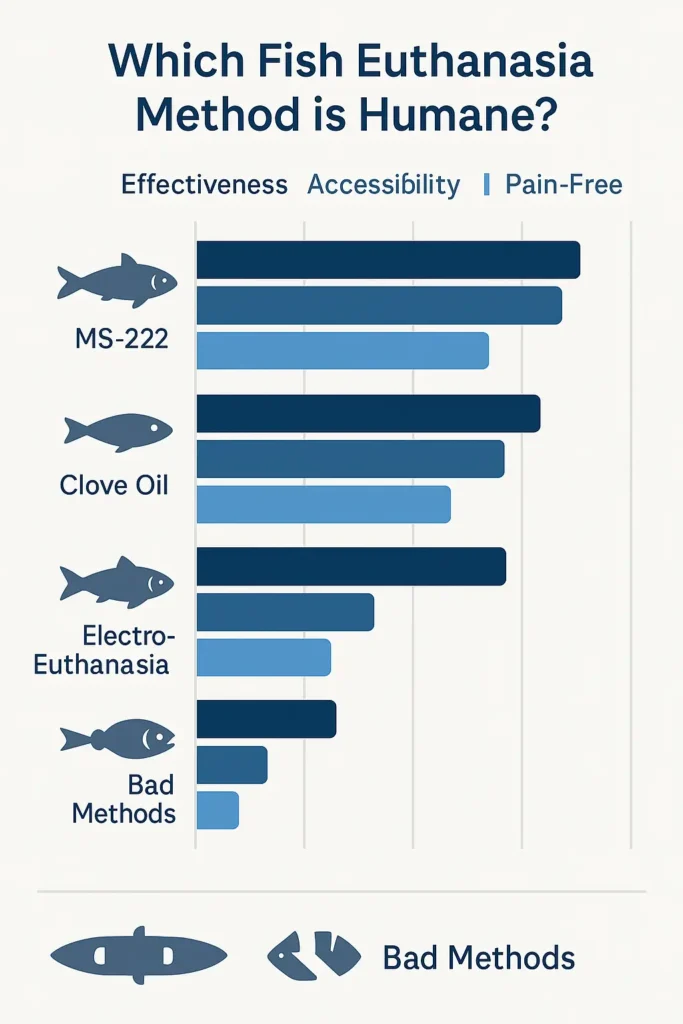To euthanize a fish humanely, use MS-222, clove oil, or electro-euthanasia. Always follow best practices to prevent pain and distress for your fish.
In a Nutshell: How To Euthanize A Fish
- Learn the safest, kindest ways to euthanize a fish.
- Understand common mistakes and why some methods cause harm.
- Get clear, step-by-step tips for each main approach.
Watching a fish suffer is hard. You want to do what is right, but it can be confusing and stressful to pick a method. The wrong choice can cause pain for your fish or guilt for you. Knowing the best way gives peace of mind and helps both you and your pet.
Estimated reading time: 5 minutes
Understanding When Fish Euthanasia Is Needed
Fish euthanasia means ending a fish’s life with as little pain as possible. This action is only considered if a fish is very sick, badly hurt, or will not recover. Signs include not eating, struggling to swim, or visible wounds. Euthanasia should always focus first on the fish’s well-being, not the owner’s convenience.
The Humane Methods: How To Euthanize A Fish

Some methods are trusted and accepted by fish experts and veterinarians:
1. Tricaine Methanesulfate (MS-222)
- Used in labs and by vets.
- Blocks nerve signals causing fish to sleep, then pass away.
- Mix the right amount into dechlorinated water, buffer to pH 7.0–7.5[^1].
- Immerse fish until breathing and movement stop, then leave for at least 30 minutes to make sure death occurs.
- Expert-recommended: safe, fast, and effective for many species.
- Hard to get for home use. Needs care to prepare and dispose of safely.
2. Clove Oil (Eugenol)
- Works by sedating fish, then leading to death with a strong enough dose.
- Add drops to warm water and mix well; put fish in and cover to reduce stress and light.
- Fish fall asleep, then pass on, but sometimes need a secondary method to make sure they do not wake up again.
- Easy to find; good for home use and small fish[^2].
- Important: Not always final—combine with another quick method if needed.
3. Electro-Euthanasia
- Sends a mild electric current to the fish, so it loses feeling and dies very quickly.
- Proven effective, especially for zebrafish in research settings[^3].
- Fast and stops pain almost at once.
- Needs special equipment and experience, so not practical for most homes.
Note on Other Methods: Freezing, chlorine, or blunt force may seem easy but cause stress or pain. They are not considered humane and should not be used[^2].
[^1]: Guidelines for Euthanasia
[^2]: Fish Euthanasia at Home
[^3]: Recent study on Electro-Euthanasia
Step-By-Step: How To Euthanize A Fish Humanely
- Choose the right method: For most people, clove oil is easiest to access. Labs and vets tend to use MS-222 or electro-euthanasia.
- Prepare supplies: Clean container, dechlorinated water, protective gloves, and the chosen agent.
- Stay calm and gentle: Move the fish to the solution with care.
- Allow full time: Wait at least 30 minutes after breathing stops.
- Confirm death: Look for no mouth or gill movement.
- Dispose of remains respectfully: Wrap in a small bag and bury, or follow local rules.
For a full walkthrough, see this step-by-step guide to humane fish euthanasia.
- Stay gentle: Handle your fish slowly to avoid stress.
- Darken the room: Fish relax in low light, so lower light before and during euthanasia.
- Buffer solutions: If using MS-222, add baking soda so water pH does not drop.
- Wait after gill movement stops: Give at least 30 minutes to be sure.
Tools and Supplies You Might Need
- MS-222 powder or clove oil (never mix types).
- Baking soda (buffering for MS-222).
- Dechlorinated water.
- Covered, quiet container.
- Gloves for your own safety.
Note: For home setups, it is much safer to use clove oil than try lab methods without training.
Clove Oil Dosage Calculator
Tip: For best results, always check water volume and mix well.Mistakes to Avoid When Euthanizing a Fish
- Using ice, boiling, or chemicals like bleach.
- Removing fish too soon.
- Skipping a second method with clove oil if the fish might wake up.
- Ignoring animal welfare guidelines.
- Acting in panic—take a moment to gather yourself first.
Confirming Death and Respectful Aftercare
After euthanasia, always check for complete lack of movement and response. If you are unsure, contact an expert. Dispose of the remains in a way that feels respectful to you and safe for others.
Personal Experience: How To Euthanize A Fish
Once, I needed to euthanize a beloved goldfish who could no longer swim straight or eat. I used clove oil after talking to an aquatic vet. The fish drifted calmly and passed in a few minutes. Taking this step was sad but felt kind, knowing I avoided pain and ended suffering.
Conclusion
Choosing how to euthanize a fish can be hard. When done with care, you protect your fish from pain and give them a gentle end. Always pick a trusted method, confirm death, and act with respect. Simple, humane steps matter most.

